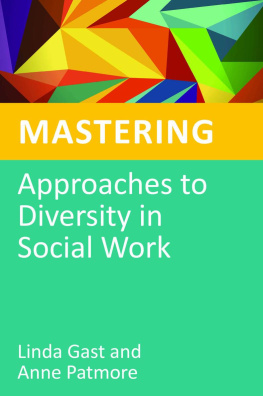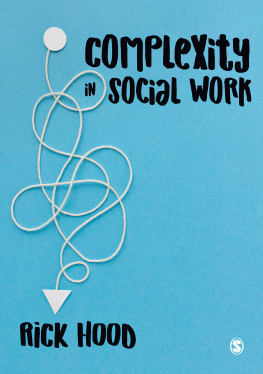In memory of Bill Reid, our model of lifelong learning.
To our students, whose questions and insights facilitate
our reflective practice as educators.

Copyright 2007 by Sage Publications, Inc.
All rights reserved. No part of this book may be reproduced or utilized in any form or by any means, electronic or mechanical, including photocopying, recording, or by any information storage and retrieval system, without permission in writing from the publisher.
For information:
Sage Publications, Inc.
2455 Teller Road
Thousand Oaks, California 91320
E-mail:
Sage Publications India Pvt Ltd.
B 1/I 1 Mohan Cooperative Industrial Area
Mathura Road, New Delhi 110 044
India
Sage Publications Ltd.
1 Olivers Yard
55 City Road
London EC1Y 1SP
United Kingdom
Sage Publications Asia-Pacific Pte Ltd.
33 Pekin Street #02-01
Far East Square
Singapore 048763
Printed in the United States of America
Library of Congress Cataloging-in-Publication Data
Challenges of living: A multidimensional working model for social workers / Elizabeth D. Hutchison [et al.].
p. cm.
Includes bibliographical references and index.
ISBN-13:978-1-4129-0899-3 (pbk. : alk. paper)
1. Social service. 2. Social problems. I. Hutchison, Elizabeth D.
HV40.C42356 2007
361.32dc22
2006031961
Printed on acid-free paper.
07 08 09 10 11 10 9 8 7 6 5 4 3 2 1
| Acquiring Editor: | Kassie Graves |
| Editorial Assistant: | Veronica Novak |
| Production Editor: | Sarah K. Quesenberry |
| Copy Editor: | Barbara Coster |
| Typesetter: | C&M Digitals (P) Ltd. |
| Proofreader: | Jennifer Ang |
| Indexer: | Sheila Bodell |
| Cover Designer: | Janet Foulger |
| Marketing Manager: | Carmel Withers |
Acknowledgments

L ike any writing project, the ideas in this book have been incubating for a number of years. Over those years, we have been informed by each others work on various other projects and by our conversations with each other. Our ideas have also been shaped by the work and contributions of many others who are far too numerous to begin to call out. For the senior author, the seeds of this book were planted during collaborative curriculum planning with colleagues at Virginia Commonwealth University and enriched, particularly, by her several years of cherished collaboration with Stephen Gilson, who is now on the faculty at the University of Maine. We are grateful to Stephen for his contributions to our understanding of biological contributions to human behavior and his keen sense of social justice. Marcia Harrigan expresses her gratitude to Drs. Kia Bentley, Janice Berry-Edwards, Rosemary Farmer, and Joe Walsh for the gracious sharing of their own scholarship and for their suggestions that helped to shape her ideas.
We are grateful to Dean Frank Baskind at Virginia Commonwealth University and Professor Virginia David, Chair of the Department of Social Work at Nazareth College, for supporting us in all of our endeavors. The senior author is grateful to Dean Baskind and her colleagues at Virginia Commonwealth University for the opportunity to be on research leave in the final weeks of completing the book. We all owe a debt of gratitude to the library staffs at Virginia Commonwealth University and Nazareth College, recognizing that their advancements in making materials electronically accessible lightened our load and gave us more snippets of time to connect with our families.
We are lucky to be working again with the folks at Sage. Art Pomponio was a cheerleader in the early stages of bringing our incubating ideas into written form, and Kassie Graves has been a very competent, focused, yet gentle shepherd through the last stages of turning a once unwieldy manuscript into a book. At a key point, Jerry Westby greased the wheels. Veronica Novak was a constant throughout the long months and diligently did her part to keep the project moving. When the drafting and redrafting finally came to an end, Sarah Quesenberry worked the magic of turning words into a book. We were pleased to have Barbara Costers competent copyediting assistance once again. There are many others at Sage who work behind the scenes doing crucial tasks that are invisible to authors. We sense your presence and appreciate all that you do.
We are also grateful for the support and encouragement of students, family, and colleagues. They enrich our lives and provide us with protective webs of connectedness. Chuck, thank you for waiting patiently weekend after weekend for Marcia to be (really) finished with her chapters. Chuck and Hutch, thank you for your good humor while assisting us with the various computer glitches.
Finally, we are grateful to the following reviewers who read an earlier draft of the book and provided helpful feedback:
Parris Baker, Gannon University
Sandra Chesborough, St. Cloud State University
Ann Dannerbeck, University of Missouri
Dorie J. Gilbert, University of Texas at Austin
Richard A. Longoria, University of Texas at Austin
Samuel MacMaster, University of Tennessee
Kimberly A. Mann, Chicago State University
Elizabeth D. Hutchison
Holly C. Matto
Marcia P. Harrigan
Leanne W. Charlesworth
Pamela A. Vigianni
A Working Model
Elizabeth D. Hutchison,
Virginia Commonwealth University
E very day, social workers meet up with complex challenges faced by individuals, families, communities, and organizations. In this book, we are presenting and demonstrating a working model to help social workers understand the many and varied challenges they will encounter in their work.
Why a Challenges of Living Approach?
Social work scholars have long attempted to find frameworks for organizing social and behavioral science knowledge about human behavior in a way that is useful for the varied roles that social workers play. Two popular approaches are a social systems approach and a life course approach. Each of those approaches makes important contributions to the understanding of the complexities of human behavior encountered by social workers (see Hutchison, 2003a, 2003b). Each has been evaluated, however, to be more helpful for the social work assessment process than for guiding intervention. In this book, we are proposing another organizational framework that we think will assist social workers to move from scientific understanding to intervention. We call this approach a












